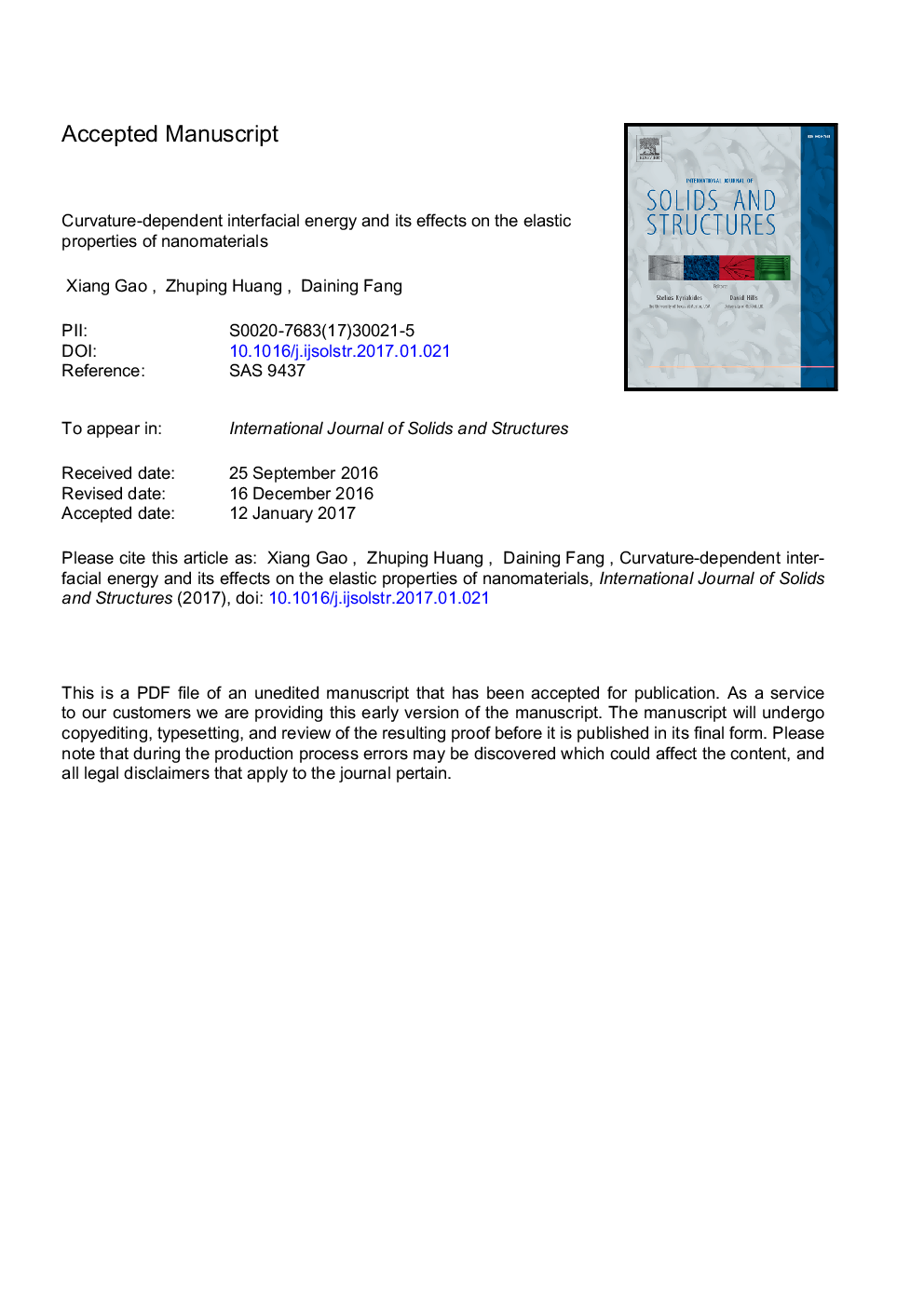| کد مقاله | کد نشریه | سال انتشار | مقاله انگلیسی | نسخه تمام متن |
|---|---|---|---|---|
| 4922473 | 1430187 | 2017 | 18 صفحه PDF | دانلود رایگان |
عنوان انگلیسی مقاله ISI
Curvature-dependent interfacial energy and its effects on the elastic properties of nanomaterials
ترجمه فارسی عنوان
انرژی بین فازی وابسته به انحنا و اثرات آن بر خواص کششی نانومواد
دانلود مقاله + سفارش ترجمه
دانلود مقاله ISI انگلیسی
رایگان برای ایرانیان
کلمات کلیدی
استرس رابط تغییر شکل کوچک، شرح لاگرانژی، رویکرد میکرومکانیک، مدول موثر،
ترجمه چکیده
رابط های مواد را می توان به عنوان سطوح منحنی دو بعدی مورد توجه قرار داد زیرا ضخامت آنها در مقایسه با ابعاد مسطح آنها ناچیز است. شبیه سازی آزمایش ها و مواد نشان داده است که انرژی کششی رابط، نه تنها بر کرنش آن، بلکه بر روی انحنای آن بستگی دارد. در این مقاله، ابتدا، وابستگی منحنی انرژی بین فازی مورد مطالعه قرار گرفته است و فرمول انرژی بین فضایی فرموله شده است که دارای فرم ساده و معانی فیزیکی واضح است. بعد، مدل تنش رابط خطی کوچک تغییر شکل توسعه یافته است. این اثر انحنایی را بر روی انرژی بین فضایی بررسی می کند و نشان می دهد که معیارهای اساسی لاگرانژی رابط برای مطالعه مشکلات رابط، به ویژه اثر استرس رابط باقی مانده، مناسب و سودمند است. سپس، یک چارچوب میکرومکانیکی با در نظر گرفتن هر دو اثر رابط و توزیع اندازه ذرات برای پیش بینی خواص کششی نانوکامپوزیت ها پیشنهاد شده است. در نهایت، مدل رابط کاربری توسعه داده شده و روش میکرومکانیکی برای مطالعه مدول موثر کامپوزیت های تقویت شده نانوذرات استفاده می شود. نتایج نشان می دهد که اثر انحنا باعث ایجاد وابستگی به اندازه بزرگتر از مدول موثر می شود و تأثیر میزان توزیع اندازه ذرات زمانی که پراکندگی شعاع ذرات بزرگ است، واضح می شود.
موضوعات مرتبط
مهندسی و علوم پایه
سایر رشته های مهندسی
مهندسی عمران و سازه
چکیده انگلیسی
Material interfaces can be regarded as two dimensional curved surfaces since their thickness is negligibly small in comparison with their planar dimensions. Experiments and materials simulation have demonstrated that the elastic energy of interface depends not only on its strain but also on its curvature. In this paper, first, the curvature-dependence of interfacial energy is studied and an interfacial energy formula is formulated, which has simple form and clear physical meanings. Next, a linear small deformation interface stress model is developed. It considers the curvature effect on interfacial energy and suggests that it would be convenient and advantageous to employ the Lagrangian description-based fundamental equations of the interface to study interface problems, especially the effect of residual interface stress. Then, a micromechanics framework considering both the interface effect and particle size distribution is proposed to predict the overall elastic properties of nanocomposites. Finally, the developed interface model and micromechanics approach are applied to study the effective modulus of nanoparticle reinforced composites. The results show that the curvature effect causes a much stronger size dependence of the effective modulus and the influence of particle size distribution becomes obvious when the dispersion of the particle radius is large.
ناشر
Database: Elsevier - ScienceDirect (ساینس دایرکت)
Journal: International Journal of Solids and Structures - Volumes 113â114, 15 May 2017, Pages 100-107
Journal: International Journal of Solids and Structures - Volumes 113â114, 15 May 2017, Pages 100-107
نویسندگان
Xiang Gao, Zhuping Huang, Daining Fang,
